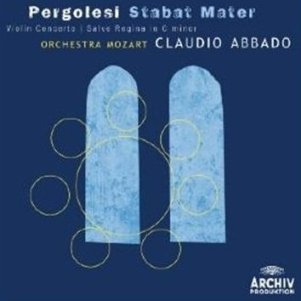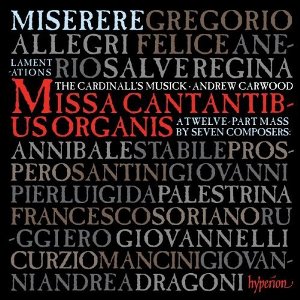Pergolesi: Stabat Mater, Violin Concerto, Salve Regina in C Minor
Originally published on musicalcriticism.com
25 August 2009
Although we are currently occupied with Handel's anniversary performances it is worth taking time to reflect that 2010 brings a Pergolesi celebration; a composer who will surely benefit greatly from the reevaluation that inevitably accompanies such attention. This autumn's new album from Claudio Abbado and Orchestra Mozart is the first of three in their eagerly anticipated Pergolesi project and, interestingly, it comes some twenty-five years after Abbado's first recording of the Stabat Mater.
This album is recorded from live performances that combine a period orchestra with the sort of nimble operatic voices that more and more early music ensembles are beginning to use. This is a combination that I find particularly exciting as it allows for a very immediate delivery of the text and a far more overt use of expression than one often hears in this work. Rachel Harnisch and Sara Mingardo are beautifully matched both in vocal prowess and musical intelligence and this is most noticeable in the imitative passages and, in particular, the famous opening movement with its anguished use of dissonance. Harnisch sets the bar very high in 'Cuius animam gementem' with the tone-colours that she employs for the sword, 'pertransivit gladius,' literally cutting through the orchestra's texture.
Mingardo recorded this piece most memorably with Rinaldo Alessandrini and his Concerto Italiano ten years ago and during the intervening decade she has lost none of her fire; her trembling in 'O quam tristis' is every bit as skilful as before. Here, as in other places, Abbado has opted for less eccentric tempi than Alessandrini did but still manages to capture that same blend of despair and beauty that is so central to the success of a performance. How different this is to the Deutsche Grammophon recording he once made with Margaret Marshall, Lucia Valentini-Terrani and the London Symphony Orchestra. Revisiting that 1980s performance highlights how much has changed in the way we view Pergolesi's work as well as the orchestras we use to perform it. Listen out for some exceptional singing from Mingardo on 'Ob amorem filii' in 'Fac, ut porten Christi mortem.' She is a contralto with a tone and range of considerable distinction.
The programme also includes the Violin Concerto in B flat major with soloist Giuliano Carmignola who plays the 1732 Baillot Stradivarius in this, his first recording of the work. This is a particularly vibrant performance which I'm sure will become a firm favorite of Pergolesi fans everywhere and it's beautifully recorded too. I particularly enjoyed the lute playing of Michele Pasotti in the introduction of the slow movement and the interaction between soloist and orchestra throughout.
Soprano Julia Kleiter closes the programme with a heartfelt performance of the Salve Regina in C minor. She finds some exquisite expression in the second movement, 'Ad te clamamus,' and again Abbado leaves us in no doubt that his Pergolesi performances will be eagerly awaited throughout 2010. I'm just left feeling a little disappointed by the odd scruffy corner of tuning from the strings. That's part of the problem of recording a live performance but now that our ears are so used to the implied perfection of studio recordings it takes some getting used to – especially with repeated listening.
The Pergolesi year will continue to be marked by this exciting partnership between Abbado and Orchestra Mozart with two further releases: the Dixit Dominus (January 2010) followed by Messa di San Emidio (March 2010).
Orchestra Mozart / Claudio Abbado (Archiv 477 8077)
25 August 2009
Although we are currently occupied with Handel's anniversary performances it is worth taking time to reflect that 2010 brings a Pergolesi celebration; a composer who will surely benefit greatly from the reevaluation that inevitably accompanies such attention. This autumn's new album from Claudio Abbado and Orchestra Mozart is the first of three in their eagerly anticipated Pergolesi project and, interestingly, it comes some twenty-five years after Abbado's first recording of the Stabat Mater.
This album is recorded from live performances that combine a period orchestra with the sort of nimble operatic voices that more and more early music ensembles are beginning to use. This is a combination that I find particularly exciting as it allows for a very immediate delivery of the text and a far more overt use of expression than one often hears in this work. Rachel Harnisch and Sara Mingardo are beautifully matched both in vocal prowess and musical intelligence and this is most noticeable in the imitative passages and, in particular, the famous opening movement with its anguished use of dissonance. Harnisch sets the bar very high in 'Cuius animam gementem' with the tone-colours that she employs for the sword, 'pertransivit gladius,' literally cutting through the orchestra's texture.
Mingardo recorded this piece most memorably with Rinaldo Alessandrini and his Concerto Italiano ten years ago and during the intervening decade she has lost none of her fire; her trembling in 'O quam tristis' is every bit as skilful as before. Here, as in other places, Abbado has opted for less eccentric tempi than Alessandrini did but still manages to capture that same blend of despair and beauty that is so central to the success of a performance. How different this is to the Deutsche Grammophon recording he once made with Margaret Marshall, Lucia Valentini-Terrani and the London Symphony Orchestra. Revisiting that 1980s performance highlights how much has changed in the way we view Pergolesi's work as well as the orchestras we use to perform it. Listen out for some exceptional singing from Mingardo on 'Ob amorem filii' in 'Fac, ut porten Christi mortem.' She is a contralto with a tone and range of considerable distinction.
The programme also includes the Violin Concerto in B flat major with soloist Giuliano Carmignola who plays the 1732 Baillot Stradivarius in this, his first recording of the work. This is a particularly vibrant performance which I'm sure will become a firm favorite of Pergolesi fans everywhere and it's beautifully recorded too. I particularly enjoyed the lute playing of Michele Pasotti in the introduction of the slow movement and the interaction between soloist and orchestra throughout.
Soprano Julia Kleiter closes the programme with a heartfelt performance of the Salve Regina in C minor. She finds some exquisite expression in the second movement, 'Ad te clamamus,' and again Abbado leaves us in no doubt that his Pergolesi performances will be eagerly awaited throughout 2010. I'm just left feeling a little disappointed by the odd scruffy corner of tuning from the strings. That's part of the problem of recording a live performance but now that our ears are so used to the implied perfection of studio recordings it takes some getting used to – especially with repeated listening.
The Pergolesi year will continue to be marked by this exciting partnership between Abbado and Orchestra Mozart with two further releases: the Dixit Dominus (January 2010) followed by Messa di San Emidio (March 2010).
Orchestra Mozart / Claudio Abbado (Archiv 477 8077)



Comments
Post a Comment